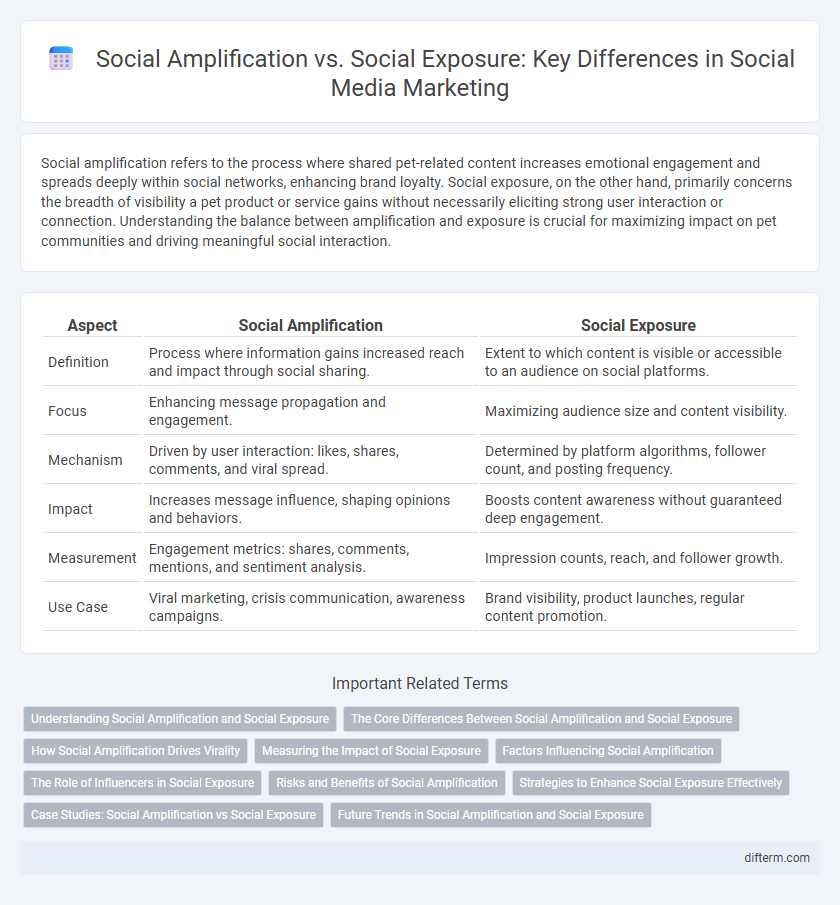Social amplification refers to the process where shared pet-related content increases emotional engagement and spreads deeply within social networks, enhancing brand loyalty. Social exposure, on the other hand, primarily concerns the breadth of visibility a pet product or service gains without necessarily eliciting strong user interaction or connection. Understanding the balance between amplification and exposure is crucial for maximizing impact on pet communities and driving meaningful social interaction.
Table of Comparison
| Aspect | Social Amplification | Social Exposure |
|---|---|---|
| Definition | Process where information gains increased reach and impact through social sharing. | Extent to which content is visible or accessible to an audience on social platforms. |
| Focus | Enhancing message propagation and engagement. | Maximizing audience size and content visibility. |
| Mechanism | Driven by user interaction: likes, shares, comments, and viral spread. | Determined by platform algorithms, follower count, and posting frequency. |
| Impact | Increases message influence, shaping opinions and behaviors. | Boosts content awareness without guaranteed deep engagement. |
| Measurement | Engagement metrics: shares, comments, mentions, and sentiment analysis. | Impression counts, reach, and follower growth. |
| Use Case | Viral marketing, crisis communication, awareness campaigns. | Brand visibility, product launches, regular content promotion. |
Understanding Social Amplification and Social Exposure
Social amplification refers to the process by which information or events gain increased attention and emotional impact through social sharing and interactions, often leading to heightened public perception and influence. Social exposure, on the other hand, measures the extent to which an individual or content is visible or encountered within social networks, focusing on reach rather than emotional or perceptual impact. Understanding the distinction between social amplification and social exposure is critical for effectively managing information dissemination strategies and predicting the societal effects of viral content.
The Core Differences Between Social Amplification and Social Exposure
Social amplification involves the intentional spreading and intensifying of messages through networks, enhancing reach and emotional impact, whereas social exposure refers to the passive presence of content visible to an audience without active promotion. Amplification leverages influencer engagement, viral sharing, and targeted campaigns to boost message visibility, while exposure depends on organic discovery and baseline audience attention. Understanding these differences is crucial for designing effective social media strategies that maximize engagement and brand awareness.
How Social Amplification Drives Virality
Social amplification drives virality by leveraging network effects where user interactions such as shares, comments, and likes exponentially increase content visibility. Algorithms prioritize highly engaged posts, pushing them to broader audiences beyond the initial followers, creating a feedback loop that accelerates content spread. This dynamic enhances social exposure but differs in that amplification generates active engagement, leading to sustained and scalable viral growth.
Measuring the Impact of Social Exposure
Measuring the impact of social exposure involves quantifying the reach and frequency with which content is seen by diverse audiences across multiple platforms. Key metrics include impressions, unique views, and engagement rates, which provide insights into the breadth and intensity of exposure. Analyzing social exposure helps determine the baseline visibility of content before amplification efforts enhance its spread and influence.
Factors Influencing Social Amplification
Social amplification is influenced by factors such as message relevance, emotional resonance, and network connectivity, which enhance the spread and impact of information beyond simple social exposure. High engagement levels on platforms and the credibility of the source further intensify amplification effects by encouraging resharing and discussion. Content that triggers strong emotional responses or aligns with group identities tends to be amplified exponentially within social networks.
The Role of Influencers in Social Exposure
Influencers play a crucial role in social exposure by amplifying brand messages to targeted audiences through their trusted voices and large followings. Their authentic engagement increases content visibility and drives organic reach beyond initial social exposure limits. Leveraging influencer partnerships enhances social amplification by turning passive viewers into active brand advocates.
Risks and Benefits of Social Amplification
Social amplification significantly increases the reach and impact of information by encouraging sharing and engagement, which benefits awareness and mobilization but carries risks like misinformation spread and heightened panic. It intensifies emotional responses, potentially leading to social polarization or stigma around certain topics. Proper management of social amplification can optimize public discourse while mitigating the dangers of exaggerated or distorted information.
Strategies to Enhance Social Exposure Effectively
Implement targeted hashtag strategies and collaborate with influencers to maximize social exposure across diverse platforms, driving organic reach and engagement. Utilize data-driven content scheduling to post during peak activity times, ensuring visibility among key audience segments. Leverage interactive features like polls and live streams to foster real-time interaction, amplifying social signals and expanding content discoverability.
Case Studies: Social Amplification vs Social Exposure
Case studies in social amplification versus social exposure reveal how the depth of audience engagement significantly impacts message effectiveness. Social amplification involves active sharing, commentary, and interaction, leading to viral reach and sustained attention, as seen in campaigns like ALS Ice Bucket Challenge. In contrast, social exposure often results from passive content visibility without engagement, which limits message retention and influence despite widespread impressions.
Future Trends in Social Amplification and Social Exposure
Future trends in social amplification emphasize personalized content algorithms and influencer-driven engagement to enhance message reach and resonance. Social exposure will increasingly rely on immersive technologies like augmented reality and virtual reality to create authentic and interactive experiences. Data privacy and ethical considerations will shape platform policies, influencing how amplified content spreads across diverse digital communities.
social amplification vs social exposure Infographic

 difterm.com
difterm.com